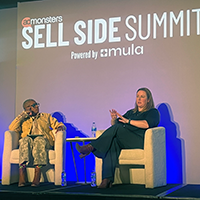Let’s take a moment and congratulate both Microsoft and Yahoo.
Realizing that they can’t compete with Google on search and practically any other area of Internet advertising, they did manage to out do Google in the coverage dedicated to them this year, thanks in no large part to their almost arranged marriage. Some notable updates have found their way to the press since Microsoft called off their proposed acquisition, both on the Yahoo front with Carl Icahn and with news emerging that Microsoft could be looking at a joint venture with Yahoo instead of a full buyout. Perhaps feeling positive about its ability to generate news, Microsoft decided to see how well it could fair with a non-Yahoo, Internet advertising related announcement. This news, which came out yesterday, doesn’t pertain to any acquisition, not directly at least. On the surface it looks much more like Microsoft renewing its efforts to gain some market share on Google, as it deals with their Live Search product, their Google.com if you will. It also takes a play straight from the incentive marketers, and more than an attempt to draw users away from Google, it reads at first like any number of lesser-branded attempts where companies try to share search profits with users. In typical Microsoft fashion, they absolutely nailed the branding. If Live Search cashback doesn’t have you instantly updating your bookmarks and installing a Live Search toolbar, I don’t know what will. And, it must be a big deal, if Bill Gates decided to speak on it at their annual advertisers’ gathering. Although, given the nature and timing of the product, I find it surprising that Bill Gross didn’t give the speech, instead of Bill Gates.
This latest move stems from an acquisition that Microsoft did in early October of last year, when they announced that they would acquire one of our favorite sites, Jellyfish.com. For those unfamiliar with Jellyfish, they took a model that long time industry veterans like David Lewis with Cashbaq.com pioneered years early, and that is sharing part of the affiliate commissions with the users. This newest crop of sites doesn’t differ that wildly from incentive pioneer Netflip, at least not in the business model. Jellyfish distinguished itself from the others not in the model of sharing revenue with users but in its depth of products. It could go head to head with just about any of the more established comparison shopping companies, all while offering an interface and user experience second to none. The same, unfortunately, cannot be said of Live Search cashback. Microsoft seems to have spent the past seven or so months, since the acquisition, creating a site with all the visual appeal of a can of tuna. Given that Jellyfish might not have right brand connotations of this multi-hundred billion dollar behemoth, it makes sense that they might rebrand, but you do have to question their need to bring the rest of the site down to the level of Live.com as opposed to the other way around. Knowing now though, that Live Search cashback represents just a rebrand of Jellyfish and Microsoft’s move into the comparison shopping space – as opposed to something grander such as a broader pay for performance model – we can focus on the real task at hand, lamenting how both Microsoft and Yahoo still don’t get it.
Do you know a company that gets it? SocialMedia Networks. Why do they get it? Because they understand that it’s about monetization. They also understand that it’s about the power of the network and becoming a viable alternative to Google. Not that SocialMedia has become a true alternative to Google, they have done what Microsoft and Yahoo have not – aggregated inventory on an emerging platform, in this case social media. Facebook, for that company has done right, has in some ways missed the boat on their own inventory. Many kudos to them for enabling the next generation of websites to flourish within their universe. The application space is nothing less than what the web was years ago when services like AOL ruled. All the content, in this case, the applications, take place inside of Facebook. Instead of Facebook trying to control what gets created, they allowed others to do so. It doesn’t hurt them because whatever gets created, especially those that become popular, only add value to Facebook. Where they missed the boat so far is by focusing on monetizing only their own inventory. In another brilliant move, the company allows application developers to own some ad inventory, but Facebook should have been one of the first to try and help those developers make money. The application space should have been their equivalent to the Google content network. If I were them (and really on thanks to hindsight), I would have focused less on some of the unproven monetization strategies and focused entirely on leveraging the application inventory to build scale in the advertiser base. We need an alternative to Google. This is one way.
If only Microsoft and Yahoo truly understood that the world needs competitor to Google. They say they want to compete with Google, but they’re not serious. They spend like they’re serious, but they really aren’t serious about creating a competitor. Advertising.com realized early on that they couldn’t compete with the sites that had the users, so they focused on the network. For all the acquisitions between Microsoft and Yahoo, they still haven’t focused on the network. They want to focus on their owned sites. They need to focus on the ones they monetize. Google might make a billion dollars in display, but they make almost all their money from that one core contextual product. We have all watched as AdSense has grown in power, even to the point now where publishers fear taking down the code for reprisal in their organic traffic. Through all this time, though, neither company really dedicated itself to creating a viable competitor, and that’s where they could. Google’s content network does not have the same long-term stranglehold that other aspects of their business do. If a company like Microsoft wants to spend billions on search, then lock down inventory and work on a decent contextual product. Buy a few crappy ad networks and those with a built in advertiser base if they must. For all its muster, Google often doesn’t overarchitect in the beginning. Most of their products work just well enough and have room to grow, but they don’t come out of the gate working perfectly. For Microsoft and Yahoo, it’s not too late, especially in the network business, but reduce the focus on display and increase the inventory and focus to creating a Google AdSense competitor.



